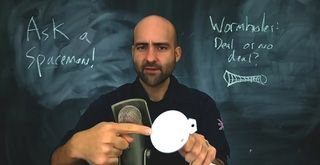'Ask a Spaceman' Reveals Why You Wouldn't Want to Enter a Wormhole
Whether you're a fan of "Star Trek,", "Doctor Who" or the Marvel universe, all of these franchises have at least one thing in common —– they use wormholes to move people through space rapidly. Are wormholes a real thing, or just a staple of science fiction?
In the latest installment of "Ask A Spaceman,"a weekly show on Facebook Watch presented by Space.com, astrophysicist and Space.com columnist Paul Sutter explains that why even if wormholes do exist, trying to use one is a really bad idea.
"Wormholes, right?" says Sutter says in today's episode, which is Episode 6 of the series overall. "[They are] a staple of science fiction, where you can just —– boop! —- go somewhere else in the universe as fast as the plot needs to go."
To understand how a (theoretical) wormhole works, first you need to know a bit about the science of black holes, which Sutter covered in Episode 4 and Episode 5. Basically, there are several kinds of black holes. The type that Sutter focuses on is stellar-mass black holes, which happen after huge stars reach the end of their lives and explode in a supernova.

After a supernova happens, the resulting gravitational collapse creates a black hole, which is an extremely massive object that traps all matter and light that get too close. Black holes can only be seen only by using the radiation they emit, or by tracking their gravitational effects on other objects. And they are one possible way of generating a wormhole.
If you picture a black hole as a funnel, Sutter explains in the video, objects that get "trapped" in the black hole pass beyond its event horizon (the mouth of the funnel) and then move down. So, where's the wormhole? It's an equal and opposite funnel attached to the black hole funnel, mouths facing outwards. Sometimes this kind of wormhole is called a "white hole."
There are a few problems with the white hole theory, Sutter said. It's hard to figure out exactly how you get in to the white hole from the black hole. The mathematics behind white holes show that they are incredibly unstable. White holes might evaporate or even "snuff out" a black hole altogether after forming.
Get the Space.com Newsletter
Breaking space news, the latest updates on rocket launches, skywatching events and more!
But even if wormholes connecting a black and a white hole could exist, they are deadly. Because once a person or a spacecraft gets in to the black- hole- event horizon, they would just get trapped, Sutter saidexplains. There's no way they could escape the hole from either the black hole side or the white hole side, because, by definition, you can never pass back out beyond a black hole's event horizon; you have to go to the singularity, whether or not it's connected to a white hole singularity.
So maybe it's best to leave the wormholes and "wibbly wobbly" science of time to "Doctor Who," or one of the "Star Trek" captains.
The episodes will be released weekly on Wednesdays at 12 p.m. EDT (1600 GMT), so " like" the Facebook page or check back later to see more. Sutter also responds to reader questions in every episode. Click here to learn more about past topics the show has covered, such as the Big Bang and Pluto.
Sutter is a cosmologist at Ohio State University and chief scientist at Columbus Ohio's the Center of Science and Industry in Columbus, Ohio. He has a long-running podcast, also called "Ask A Spaceman.". You can catch all past episodes of his podcast here.
Follow us @Spacedotcom, Facebook and Google+. Original article on Space.com.
Join our Space Forums to keep talking space on the latest missions, night sky and more! And if you have a news tip, correction or comment, let us know at: community@space.com.

Elizabeth Howell (she/her), Ph.D., is a staff writer in the spaceflight channel since 2022 covering diversity, education and gaming as well. She was contributing writer for Space.com for 10 years before joining full-time. Elizabeth's reporting includes multiple exclusives with the White House and Office of the Vice-President of the United States, an exclusive conversation with aspiring space tourist (and NSYNC bassist) Lance Bass, speaking several times with the International Space Station, witnessing five human spaceflight launches on two continents, flying parabolic, working inside a spacesuit, and participating in a simulated Mars mission. Her latest book, "Why Am I Taller?", is co-written with astronaut Dave Williams. Elizabeth holds a Ph.D. and M.Sc. in Space Studies from the University of North Dakota, a Bachelor of Journalism from Canada's Carleton University and a Bachelor of History from Canada's Athabasca University. Elizabeth is also a post-secondary instructor in communications and science at several institutions since 2015; her experience includes developing and teaching an astronomy course at Canada's Algonquin College (with Indigenous content as well) to more than 1,000 students since 2020. Elizabeth first got interested in space after watching the movie Apollo 13 in 1996, and still wants to be an astronaut someday. Mastodon: https://qoto.org/@howellspace
Most Popular

